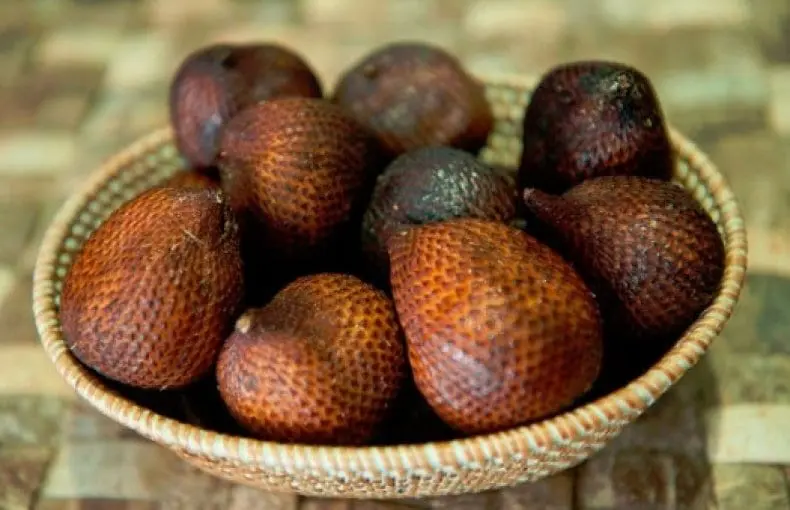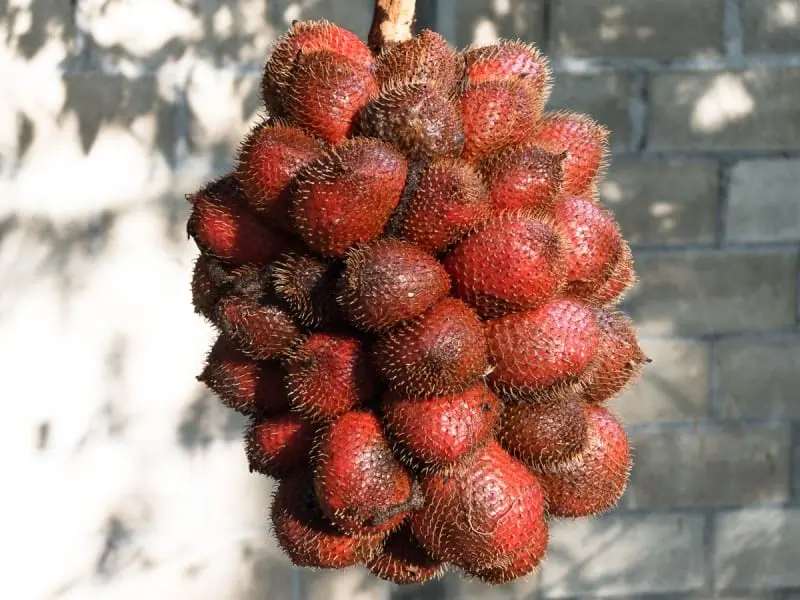Contents
Description
Snake fruit is an exotic tropical plant from the Palm family. The homeland of Snake fruit is Southeast Asia. In Malaysia and Thailand, the crop is harvested from June to August, in Indonesia, the palm tree bears fruit all year round. It is believed that the most delicious fruits grow in Bali and Java, near Yogyakarta. These fruits are little known in other countries due to the complexity of their transportation – Snake fruit spoils very quickly.
The plant is also known under the names: in English-speaking countries – snake fruit, in Thailand – sala, rakum, in Malaysia – salak, in Indonesia – salak.
The Baltic Snake fruit palm grows up to 2 meters in height and can produce crops for 50 years or more. The leaves are pinnate, up to 7 cm long, glossy green on the upper side, whitish on the bottom. Thorns grow on the petioles and at the base of the leaves. The trunk of the palm tree is also prickly, with scaly plates.
Flowers are female and male, brown in color, collected in thick clusters and formed near the base of the earth on the trunk. Fruits are pear-shaped or oval, tapered in a wedge-shaped manner at the base, grow in clusters on a palm tree. Fruit diameter – up to 4 cm, weight from 50 to 100 g. Fruits are covered with unusual brown skin with small thorns, similar to snake scales.

The pulp of the fruit is beige, consists of one or several parts, tightly connected to each other. Inside each segment of the pulp there are 1-3 large oval-shaped brown bones. Snake fruit tastes refreshing, similar to pineapple with banana, which complements the light flavor and aroma of the nut. Unripe fruits are highly astringent in taste due to their high tannin content.
In the Indonesian islands, this plant is widely cultivated on large plantations, provides the main income for the inhabitants and helps to develop the local economy. Palm trees are grown in special breeding nurseries, for which only high quality seeds are used.
Parent trees are selected according to several criteria: yield, good growth, resistance to diseases and pests. Already grown seedlings, which are several months old, are planted on plantations.
Residents plant palm trees as hedges around the perimeter of their homes, and they make fences from chopped prickly leaves. Palm trunks are not suitable as a building material, but some types of bark are of commercial value. In the industry, palm petioles are used to weave original rugs, and the roofs of houses are covered with leaves.
Snake fruit is very similar to another fruit called crayfish. They are very similar, but rakam has a red rind and a more concentrated flavor. Other names for Snake fruit: lard, snake fruit, rakum, salak.
Composition and calorie content

Snake fruit contains a number of very useful substances – beta-carotene, vitamin C, proteins, carbohydrates, dietary fiber, calcium, phosphorus, iron and thiamine.
- Calorie content 125 kcal
- Protein 17 g
- Fat 6.3 g
- Water 75.4 g
The benefits of snake fruit
The fruits of Snake fruit contain many useful substances necessary for the human body. 100 g of snake fruit contains 50 kcal, it contains vitamin C, beta-carotene, fiber, minerals, phosphorus, iron, calcium, organic acids, polyphenolic compounds and a lot of carbohydrates. Vitamin A in fruits is 5 times more than in watermelons.
Tannins and tannins contribute to the elimination of harmful substances from the body. Calcium improves the condition of hair, bones and nails. Ascorbic acid strengthens the immune system and helps the body resist viruses and infections.
Regular consumption of fruits improves vision and has a beneficial effect on the brain, dietary fiber has a beneficial effect on the digestive tract and helps with constipation.
The Snake fruit rind contains pterostilbene. The fruits are a good antioxidant and have anti-cancer properties, serve as a good prevention of cardiovascular diseases, strokes and diabetes mellitus, stimulate cell regeneration, regulate water and hormonal balance in the body, improve memory, lower blood cholesterol, have a beneficial effect on the nervous system and suppress symptoms of menopause.
A special decoction is prepared from the peel, which cheers up and helps with stress.

The fruits have the following properties:
- antihemorrhoidal
- hemostatic
- antidiarrheal
- astringent
Contraindications
It is not recommended to eat Snake fruit for individual intolerance. If this is your first time trying the fruit, you can’t eat a lot, try and wait. If the body reacted normally, you can continue to eat Snake fruit, but in any case you should not overeat.
Unripe fruits should not be washed down with milk and it is generally undesirable to include them in the diet, they contain a large amount of tannins, which in the body bind to fiber and turn into a dense mass, it is retained in the stomach. In this case, if a person has weak gastrointestinal motility and low acidity, constipation and intestinal obstruction may begin.
Application in medicine
The fruits, peels, and leaves of the plant are used to treat several health problems:
- hemorrhoids
- constipation
- bleeding
- poor eyesight
- inflammation and irritation of the intestines
- heartburn
- In the homeland of the fruit, pregnant women often use it against nausea with toxicosis.
How to choose and store Snake fruit

When buying fruits, it is important to make the right choice so as not to get green or spoiled ones:
- ripe fruit has a pleasant and rich aroma;
- the peel of a ripe Snake fruit of a dark shade – a purple or pink peel indicates that the fruit is unripe;
- smaller fruits are sweeter;
- when pressed, the Snake fruit should be hard, soft fruits that are overripe and rotten;
- unripe Baltic Snake fruit is sour, tasteless and bitter.
- It is very important to maintain good hygiene and wash fruits before eating. If Snake fruit was transported to another country, it could be treated with chemicals to keep it fresh, which, if ingested, could cause poisoning.
Fruits are stored in the refrigerator for no more than 5 days. Fresh Snake fruit spoils very quickly, so it should be eaten or cooked as soon as possible.
How to eat Snake fruit
The peel of the fruit, although it looks tough and prickly, is thin in density and in a ripe fruit it leaves quite easily. The skin is peeled off like a shell from boiled eggs. If this is your first time meeting Snake fruit, it is best to do everything carefully so as not to prick on the thorns on the skin. Fruit cleaning is carried out as follows:
- take a knife and a thick cloth tea towel;
- hold the fruit with a towel and carefully cut off the sharp tip of the top;
- in the cut off place, pry the peel with a knife and make longitudinal cuts between the Snake fruit segments;
- hold the peel with a knife or fingernail and carefully remove it;
- Divide the peeled fruit into segments and remove the seeds.
Cooking applications

They eat the fruits of Snake fruit in their raw form, peeling them off, they prepare salads, various dishes, stewed fruit, jelly, jams, preserves, smoothies, unripe fruits are pickled. In Indonesia, candied fruits are made from the fruits; unripe fruits are used to make spicy salad. Snake fruit juice mixed with carrot juice is used in the dietary menu.
In Thailand, sauces, crackers and various dishes are prepared from fruits, which are heat-treated. In Bali, in the village of Sibetan, a unique wine drink Salacca wine bali is prepared from the fruits, which is in demand among tourists and connoisseurs of original alcoholic beverages. In Indonesia, Snake fruit is boiled in sugar, and unripe fruits are kept for 1 week in a marinade of salt, sugar and boiled water.










